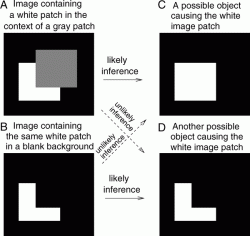Study shows how context dictates what we believe we see
Feb 22, 2008 - 7:21:30 AM
, Reviewed by: Dr. Himanshu Tyagi
|
|
|
“This is because people are mentally better prepared to see something vague when the surrounding context is also vague"
|
|
Level of Evidence
|
|
3b - Individual Case-Control Study
|
|
|
Key Points of this article
|
|
Illusionists have been alive to this phenomenon for years
|
|
|
|
|
Main results
|
|
The data suggest that brain areas beyond the primary visual cortex along the visual pathway are responsible for inferring object causes for input images.
|
|
|
About UCL
|
Founded in 1826, UCL was the first English university established after Oxford and Cambridge, the first to admit students regardless of race, class, religion or gender, and the first to provide systematic teaching of law, architecture and medicine. In the government’s most recent Research Assessment Exercise, 59 UCL departments achieved top ratings of 5* and 5, indicating research quality of international excellence.
UCL is in the top ten world universities in the 2007 THES-QS World University Rankings, and the fourth-ranked UK university in the 2007 league table of the top 500 world universities produced by the Shanghai Jiao Tong University. UCL alumni include Marie Stopes, Jonathan Dimbleby, Lord Woolf, Alexander Graham Bell, and members of the band Coldplay
|
|
[RxPG] Scientists at UCL (University College London) have found the link between what we expect to see, and what our brain tells us we actually saw. The study reveals that the context surrounding what we see is all important – sometimes overriding the evidence gathered by our eyes and even causing us to imagine things which aren’t really there.
The paper reveals that a vague background context is more influential and helps us to fill in more blanks than a bright, well-defined context. This may explain why we are prone to ‘see’ imaginary shapes in the shadows when the light is poor.
Eighteen observers were asked to concentrate on the centre of a black computer screen. Every time a buzzer sounded they pressed one of two buttons to record whether or not they had just seen a small, dim, grey ‘target’ rectangle in the middle of the screen. It did not appear every time, but when it did appear it was displayed for just 80 milliseconds (80 one thousandths of a second).
“People saw the target much more often if it appeared in the middle of a vertical line of similar looking, grey rectangles, compared to when it appeared in the middle of a pattern of bright, white rectangles. They even registered ‘seeing’ the target when it wasn’t actually there,” said Professor Zhaoping, lead author of the paper. “This is because people are mentally better prepared to see something vague when the surrounding context is also vague. It made sense for them to see it – so that’s what happened. When the target didn’t match the expectations set by the surrounding context, they saw it much less often.
 |
| Demonstration of Inferences of Objects from Images
(A) and (B) show two images containing the same white patch, and (C) and (D) show the two possible inferred objects in the scene causing this white patch. The inferred causes for any particular input image patch is not unique, although some inferences are more likely than others. The difference in the most likely inferred object for the same image patch in (A) and (B) demonstrates that inference could be greatly influenced by the image context. |
“Illusionists have been alive to this phenomenon for years,” continued Professor Zhaoping. “When you see them throw a ball into the air, followed by a second ball, and then a third ball which ‘magically’ disappears, you wonder how they did it. In truth, there’s often no third ball - it’s just our brain being deceived by the context, telling us that we really did see three balls launched into the air, one after the other.
“Contrary to what one might expect, it is a vague rather than a bright and clearly visible context that most strongly permits our beliefs to override the evidence and fill in the blanks. In fact, a bright and clearly visible context actually overrides the evidence in the opposite direction - suppressing our ‘seeing’ of the vague target even when it is present.
“Mathematical modelling suggests that visual inference through context is processed in the brain beyond the primary visual cortex. By starting with a relatively simple experiment such as this, where visual input can be more easily and systematically manipulated, we are gaining a better understanding of how context influences what we see. Further studies along these lines can hopefully enable us to dissect the workings behind more complex and wondrous illusions.”
| Funding information and declaration of competing interests:
The research was funded by the Gatsby Charitable Foundation and a Cognitive Science Foresight Grant.
|
Advertise in this space for $10 per month.
Contact us today.
|
 |
|
Subscribe to Cognitive Science Newsletter
|
|
|
|
About Dr. Himanshu Tyagi
|
This news story has been reviewed by Dr. Himanshu Tyagi before its publication on RxPG News website. Dr. Himanshu Tyagi, MBBS is the founder editor and manager for RxPG News. In this position he is responsible for content development and overall website and editorial management functions. His areas of special interest are psychological therapies and evidence based journalism.
RxPG News is committed to promotion and implementation of Evidence Based Medical Journalism in all channels of mass media including internet.
|
|
Feedback
|
For any corrections of factual information, to contact the editors or to send
any medical news or health news press releases, use
feedback form
|
Top of Page
|



